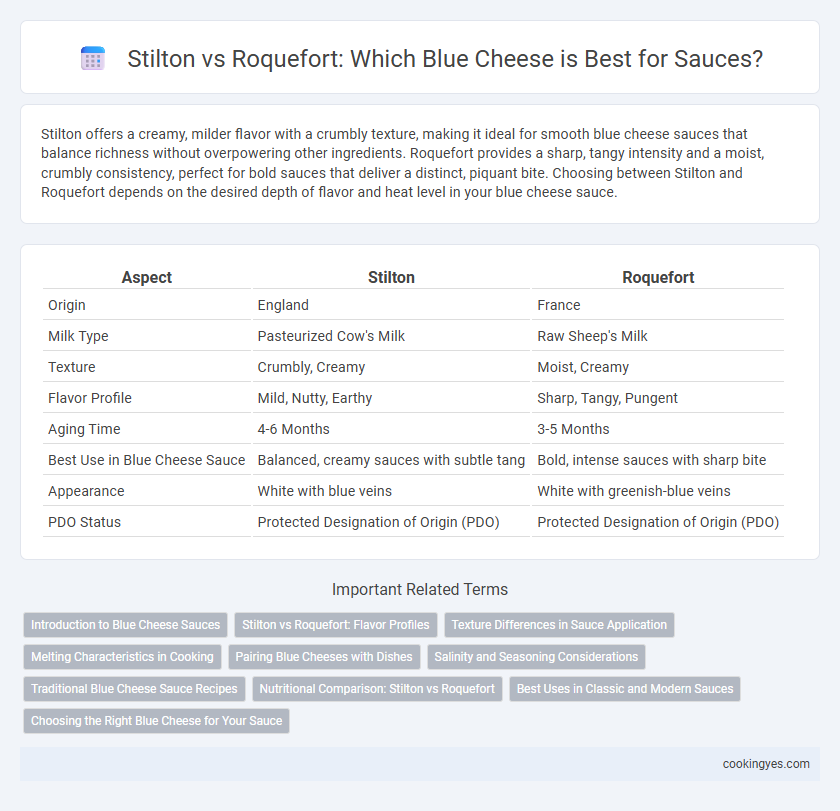Stilton offers a creamy, milder flavor with a crumbly texture, making it ideal for smooth blue cheese sauces that balance richness without overpowering other ingredients. Roquefort provides a sharp, tangy intensity and a moist, crumbly consistency, perfect for bold sauces that deliver a distinct, piquant bite. Choosing between Stilton and Roquefort depends on the desired depth of flavor and heat level in your blue cheese sauce.
Table of Comparison
| Aspect | Stilton | Roquefort |
|---|---|---|
| Origin | England | France |
| Milk Type | Pasteurized Cow's Milk | Raw Sheep's Milk |
| Texture | Crumbly, Creamy | Moist, Creamy |
| Flavor Profile | Mild, Nutty, Earthy | Sharp, Tangy, Pungent |
| Aging Time | 4-6 Months | 3-5 Months |
| Best Use in Blue Cheese Sauce | Balanced, creamy sauces with subtle tang | Bold, intense sauces with sharp bite |
| Appearance | White with blue veins | White with greenish-blue veins |
| PDO Status | Protected Designation of Origin (PDO) | Protected Designation of Origin (PDO) |
Introduction to Blue Cheese Sauces
Stilton and Roquefort represent two iconic blue cheeses often used in blue cheese sauces, each offering distinct flavor profiles and textures. Stilton provides a creamy, milder taste with a crumbly yet smooth consistency, ideal for rich and balanced sauces. Roquefort delivers a sharp, tangy, and intense flavor with a moist, creamy texture, creating bold and pungent sauces favored in French cuisine.
Stilton vs Roquefort: Flavor Profiles
Stilton offers a rich, creamy texture with a milder, nutty flavor profile that complements blue cheese sauces without overpowering other ingredients. Roquefort features a sharper, tangier taste with distinct piquant and salty notes, lending a more intense flavor to sauces. Choosing between Stilton and Roquefort for blue cheese sauces depends on the desired balance of creaminess versus bold, pungent character.
Texture Differences in Sauce Application
Stilton cheese creates a creamy, slightly crumbly texture in blue cheese sauces, allowing for smooth melting and a rich mouthfeel ideal for pasta or steak accompaniments. Roquefort, with its softer, more moist texture, integrates quickly into sauces, producing a tangier, more robust consistency that enhances dressings or dips with its intense blue mold flavor. Selecting Stilton provides a thicker, velvety sauce while Roquefort yields a thinner, sharper sauce profile tailored to different culinary applications.
Melting Characteristics in Cooking
Stilton exhibits a creamier texture and melts smoothly, making it ideal for blue cheese sauces that require a rich, velvety consistency. Roquefort, with its crumbly structure and higher moisture content, tends to break down more quickly but can create a sharper, more intense flavor profile when melted. Chefs often prefer Stilton for its balanced melting characteristics while Roquefort is chosen for sauces aiming for bold, pungent taste.
Pairing Blue Cheeses with Dishes
Stilton offers a creamy, milder flavor with nutty undertones that pairs exceptionally well with beef dishes and pears, enhancing a blue cheese sauce's balance without overpowering the palate. Roquefort delivers a sharper, tangy intensity accentuated by its crumbly texture, making it ideal for sauces accompanying lamb or robust salads, providing a pronounced and savory depth. Both cheeses complement savory and sweet elements differently, allowing chefs to tailor blue cheese sauces to specific dish profiles with precision.
Salinity and Seasoning Considerations
Stilton offers a milder salinity and creamier texture, making it ideal for sauces that require subtle seasoning and a smooth, rich flavor profile. Roquefort, with its higher salt content and sharper, tangier notes, provides a more pronounced seasoning, suitable for bold, intensely flavored blue cheese sauces. Balancing salinity is crucial, as Roquefort's saltiness can dominate a dish, whereas Stilton allows for greater control over additional seasoning.
Traditional Blue Cheese Sauce Recipes
Traditional blue cheese sauce recipes often highlight Stilton and Roquefort as prime choices, each offering distinct flavor profiles. Stilton, an English blue cheese, provides a milder, creamier texture ideal for a balanced sauce, while Roquefort, a French sheep's milk cheese, delivers a sharper, tangier taste perfect for bold culinary applications. Selecting between Stilton and Roquefort depends on the desired intensity and authenticity of the blue cheese sauce.
Nutritional Comparison: Stilton vs Roquefort
Stilton cheese contains approximately 33 grams of fat and 23 grams of protein per 100 grams, providing a rich and creamy texture ideal for blue cheese sauces. Roquefort, made from sheep's milk, offers higher sodium levels and contains about 27 grams of fat and 21 grams of protein per 100 grams, contributing to its intense flavor profile. Both cheeses provide essential nutrients like calcium and phosphorus but differ in fat content and saltiness, influencing their suitability for various blue cheese sauce recipes.
Best Uses in Classic and Modern Sauces
Stilton offers a creamy, milder flavor ideal for classic British blue cheese sauces such as Welsh rarebit and croque-monsieur, providing smooth melting qualities that blend well with cream and mustard. Roquefort, with its sharp, tangy intensity and crumbly texture, excels in modern sauces that highlight bold flavors like pear, walnut, and honey pairings, perfect for drizzling over grilled meats or roasted vegetables. For blue cheese sauces, Stilton suits traditional recipes requiring subtle richness, while Roquefort delivers a punchy, complex profile favored in contemporary culinary creations.
Choosing the Right Blue Cheese for Your Sauce
Stilton offers a creamy texture and mild, nutty flavor that blends smoothly into blue cheese sauces, making it ideal for a rich yet balanced taste. Roquefort, known for its sharp, tangy intensity and crumbly texture, delivers a more pronounced flavor profile perfect for bold, zesty sauces. Selecting Stilton or Roquefort depends on whether a mellow creaminess or robust pungency is desired for your blue cheese sauce.
Stilton vs Roquefort for blue cheese sauces Infographic

 cookingyes.com
cookingyes.com